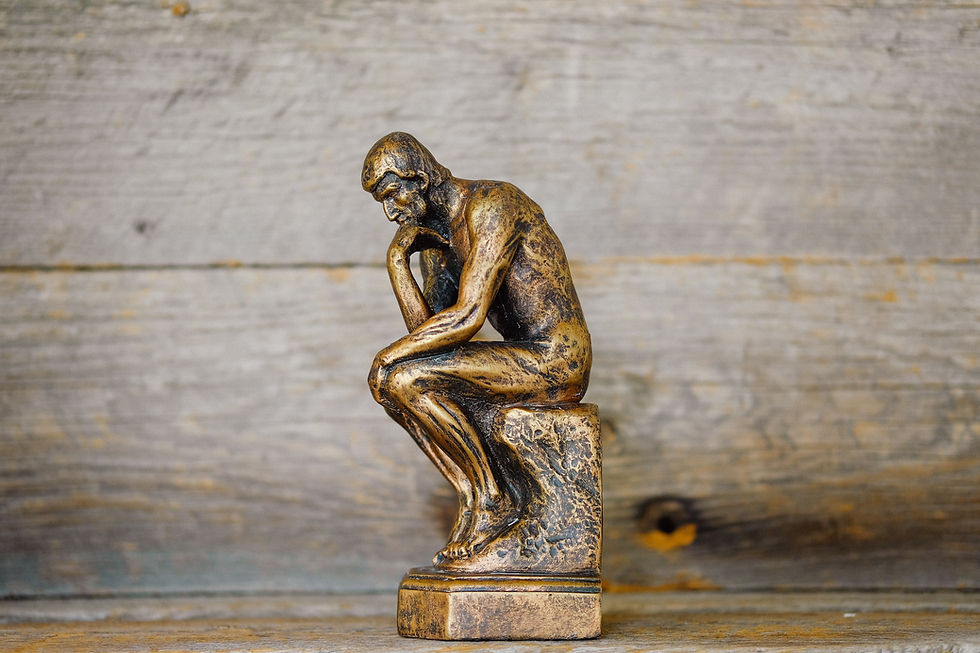Disentangling from Anxiety
- RJ Rongcal
- Sep 7, 2022
- 4 min read
Updated: Sep 18, 2022
When we stop clinging to our beliefs and thoughts, they begin to unravel.
For many of us, it's as if worrisome thoughts have been embroidered into the tissue of our flesh. They have just been an unalterable part of our lives, like gravity. But despite the incessant discomfort and pain those worrisome thoughts cause, we can never seem to disentangle from them. So, here are three words - practice instructions - that I carry around with me often and have been very helpful for my own well-being.
Be
When we can simply be, then life affords us more possibilities beyond the familiar - yet dark and clunky - roads of worry and anxiety. Being is an embodied presence. Even in the midst of doing, we can still be embodied. And when our awareness sinks below our skull, there is an immediate alleviation of anxiety because anxiety is (mostly, but not completely) a heady undertaking. Train in embodied presence - over and over and over - and we begin to feel anxious thoughts untangle from our flesh, bone, and marrow.

Feel
Feeling is expansive. We can feel our hands, we feel our hearts, and we can also feel the energy in a room. What does it feel like to be human? No one feels truly themselves when worry pervades. So we feel through into this experience of life, cutting through knots of worry because we have established some basis of embodied presence. When we feel, we open our senses more fully. Beyond the body, we notice objects, sounds, color, texture, and so on. And in this direct experience of feeling, anxious thoughts can only lay dormant.
Allow
Compulsively striving to change our predicament only causes more stress because the search to free ourselves from agitation is coming from a mind that is itself agitated. So we must first allow the experience to be as it is. This means we stop fighting; we stop trying to control every little thing in our life. And in this dissipation of fighting and struggle, we begin to taste peace.
Being - Feeling - Allowing.
Simple, but not easy.
I think it could be easier, however, to understand a little more the mechanics behind worry and anxiety, particularly around how we identify and believe in certain thought patterns.
Identifying with Thoughts Drives Suffering
They are thinking _________ about me. is an example of identifying with a thought as if it were me, as if it were true.
Believing our thoughts is a way of identifying with them.
But what about thoughts of say, compassion or gratitude? Thoughts do not need to be identified with to have an impact. Thoughts do not need a "doer" or a "thinker" behind them to exist at all. And so, thoughts do not need to be owned or copyrighted. I am terrible! is a thought. If there is no "thinker" behind the thought, then to whom could the thought be directed? It has nowhere to land. It's just a thought, nothing more nothing less.

For thoughts to have a positive, negative, or neutral impact, they do not need to be believed, per se. They can simply serve as sign posts that tell us which direction our mind is heading, where it is, or where it has been. But when thoughts are turned into beliefs as something that is fixed and true, they lodge into us with a steel hook of self-identification. A thought: I always get nervous around that person, and I bet they think I'm so awkward. What curriculum or textbook of life teaches us that it is a good idea to believe such an accusation?!
Worry Gives a False Sense of Security
Unfortunately, many of us have lived so much of our lives incessantly identifying with anxious thoughts, that anything different feels foreign and strange. When we don't allow ourselves to worry about an upcoming meeting, for example, there is a moment of peace followed by an odd feeling: I'm not worrying about that thing tomorrow, but now I'm worrying that I SHOULD be worrying about it!
This is incessant doing. Worrying gives us a sense that we are doing something. And since have been trained since we were in diapers that when we do something good we get praised, we have been constantly DOING! That's what society, family, etc. have taught us we are supposed to do. The doing of worrying has brought a false sense of security because it's a kind of doing, and doing is familiar. Humans feel more comfortable, in general, with what's familiar.
Something's Got to Give
When we realize we just can't take it anymore, all the doing, worrying, and anxious thinking, remember embodied presence. Remember feeling. And allow. Over and over and over again. We forget, but then we remember; forget then remember, over and over.
Being (in the body).
Feeling (the emotional landscape, and the surrounding space).
Allowing (the moment to be as it it is, giving up trying to constantly control or change it).
Then the veils of intellect that conceal our humanness can begin to disentangle from the flesh and marrow of our truest selves.



Comentarios